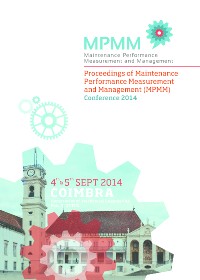Please use this identifier to cite or link to this item:
https://hdl.handle.net/10316.2/33317| DC Field | Value | Language |
|---|---|---|
| dc.contributor.author | Santos, João | |
| dc.contributor.author | Barata, Hugo | |
| dc.contributor.author | Cordeiro, Hélio | |
| dc.contributor.author | Mendonça, Cristina | |
| dc.contributor.author | Sobral, José | |
| dc.date.accessioned | 2014-09-08T10:53:25Z | |
| dc.date.accessioned | 2020-09-10T09:00:35Z | - |
| dc.date.available | 2014-09-08T10:53:25Z | |
| dc.date.available | 2020-09-10T09:00:35Z | - |
| dc.date.issued | 2014 | - |
| dc.identifier.isbn | 978-972-8954-42-0 (PDF) | |
| dc.identifier.uri | https://hdl.handle.net/10316.2/33317 | - |
| dc.description.abstract | When someone talks about assets life cycle optimization, the objective is mainly related with the reduction of operational and maintenance costs. However, regarding the newly asset management concept based on PAS 55 and the recent ISO 55000 standards family, this optimization should take into account and consider other issues like the risk associated with those decisions. Risk can be identified for each potential failure mode using a simplified FMEA (Failure Modes and Effects Analysis) and ranked or included into categories upon a determined and assumed criteria. Based on the previous risk level the decision making process aims to identify which hard time maintenance activities can be delayed in time in order to reduce maintenance costs and thus optimize the asset life cycle cost. The present paper presents a case study of equipment installed on a war vessel (diesel generators) and tries to assess if some relative hard time maintenance can be delayed without compromising safety. The amount of money to keep risk under the acceptable limits is then compared with the earning value related to the delay of maintenance activities. This work is supported by effective data gathered along the years for this specific equipment, which permits to have a realistic approach of the proposed decision. The chosen system operates on a maritime environment, has its last overhaul on 2010 and has been operating worldwide since then. | eng |
| dc.language.iso | eng | - |
| dc.publisher | Imprensa da Universidade de Coimbra | por |
| dc.publisher | Faculdade de Ciências e Tecnologia da Universidade de Coimbra, Departamento de Engenharia Mecânica | por |
| dc.relation.ispartof | Colecao:http://hdl.handle.net/10316.2/33309 | por |
| dc.rights | open access | - |
| dc.subject | FMEA | eng |
| dc.subject | diesel generator | eng |
| dc.subject | cost | eng |
| dc.subject | risk | eng |
| dc.title | Life cycle cost optimization through an asset management based on risk principles | por |
| dc.type | bookPart | por |
| uc.publication.firstPage | 49 | - |
| uc.publication.lastPage | 55 | - |
| uc.publication.location | Coimbra | por |
| dc.identifier.doi | 10.14195/978-972-8954-42-0_8 | - |
| uc.publication.digCollection | PB | por |
| uc.publication.orderno | 8 | - |
| uc.publication.area | Ciências da Engenharia e Tecnologias | por |
| uc.publication.bookTitle | Proceedings of Maintenance Performance Measurement and Management (MPMM) Conference 2014 | - |
| uc.publication.manifest | https://dl.uc.pt/json/iiif/10316.2/33317/212171/manifest?manifest=/json/iiif/10316.2/33317/212171/manifest | - |
| uc.publication.thumbnail | https://dl.uc.pt/retrieve/11181778 | - |
| uc.publication.parentItemId | 53866 | - |
| uc.itemId | 70471 | - |
| item.grantfulltext | open | - |
| item.fulltext | With Fulltext | - |
| Appears in Collections: | Proceedings of Maintenance Performance Measurement and Management (MPMM) Conference 2014 | |
Files in This Item:
| File | Description | Size | Format | |
|---|---|---|---|---|
| mpmm_artigo8.pdf | 2.27 MB | Adobe PDF |  |
Items in DSpace are protected by copyright, with all rights reserved, unless otherwise indicated.
